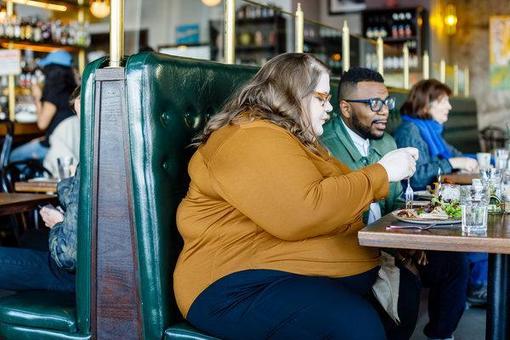
OEN Member NewsFor Larger Customers, Eating Out Is Still a Daunting Experience (The New York Times)
For Larger Customers, Eating Out Is Still a Daunting Experience
Restaurants have been slow to recognize, much less meet, the needs of plus-size Americans. But there are signs of a new activism and awareness.
Rebecca Alexander at Besaw’s Restaurant in Portland, Ore., which gets mostly high marks from AllGo, the crowdsourced mobile app she founded to help larger people find comfortable options. But here, she shows how balancing on the bar chairs is hard because they are narrow, not deep enough, and have backs.
Rebecca Alexander at Besaw’s Restaurant in Portland, Ore., which gets mostly high marks from AllGo, the crowdsourced mobile app she founded to help larger people find comfortable options. But here, she shows how balancing on the bar chairs is hard because they are narrow, not deep enough, and have backs.CreditCreditLeah Nash for The New York Times
Rebecca Alexander’s worst experience dining while large happened just after she nailed a promotion at a nonprofit organization.
She took her staff, and her new boss, to lunch at a promising downtown restaurant in Portland, Ore., where she lives. As the hostess led the group to a booth, Ms. Alexander, a 31-year-old who wears a size 30, knew in an instant there was no way she was going to squeeze into it.
“I remember having this out-of-body experience,” she said. “I watched myself sit down and try to get in even though I knew the space was too small, because I so needed it to fit.” Defeated, she asked for a table. The hostess told her there would be a half-hour wait.
“The cherry on top was that I got to be the reason we had to stand around for 30 minutes,” she said.
For people who identify as large, plus-size or fat, dining out can be a social and physical minefield. Chairs with arms or impossibly small seats leave marks and bruises. Meals are spent in pain, or filled with worry that a flimsy chair might collapse.
Deciding where to eat is a challenge. Diners often comb through endless photographs of restaurant food online, hoping someone has posted an image of the chairs or the space between tables.
Even with the best preparation, there is no way to account for a clueless employee who doesn’t notice that the bar stool with the curvy back just isn’t going to work, or the well-meaning manager who doesn’t want to call attention to a diner’s size by asking which seat might be most comfortable.
“It’s this weird thing where people are really nice when they realize what’s going on, but in my experience very few hostesses are aware ahead of time,” Ms. Alexander said. “Restaurants want to be able to serve large-bodied people, but I think they don’t know they have inadvertently created environments that are difficult for us.”
Eating in public when you live in a larger body can be challenging enough because of the judgment you may feel from others about your food choices, said Jes Baker, an author, speaker and body image coach who lives in Tucson, Ariz. And people who are fat realize that accommodating them is not always easy or practical, especially in small urban restaurants where space is at a premium and even small-framed diners feel cramped.
But restaurants don’t have to make it harder by ignoring a customer’s physical reality, she said.
“It puts the onus on the fat person,” said Ms. Baker, 32, who fluctuates between size 22 and 24. “We are the paying customers. We are paying you. We want to be comfortable and treated like humans.”
Bruce Sturgell, 39, who founded the culture and clothing website Chubstr in 2011, said he walks into every restaurant expecting to be uncomfortable. He wears a size XXL or XXXL shirt — the smaller side of big, he says.
“We’re in the early stages of this movement about fat acceptance and body positivity, and you’re seeing it in fashion and on television but not so much in restaurants,” he said.
Some restaurants are gracefully adept at accommodating extremely large customers. “The trick is to not let them know a thing while we scramble like fools to figure it out,” said Ti Adelaide Martin, whose family owns Commander’s Palace in New Orleans.
But that kind of awareness appears to be rare, even though the national girth has been growing for decades. About 40 percent of Americans over age 20 were classified as obese in a 2017 report by the Centers for Disease Control and Prevention.
“We are in a great cultural moment where people are talking about equity and inclusion, and size falls into that,” said Cheryl Durst, 57, chief executive of the International Interior Design Association.
Source: www.nytimes.com

